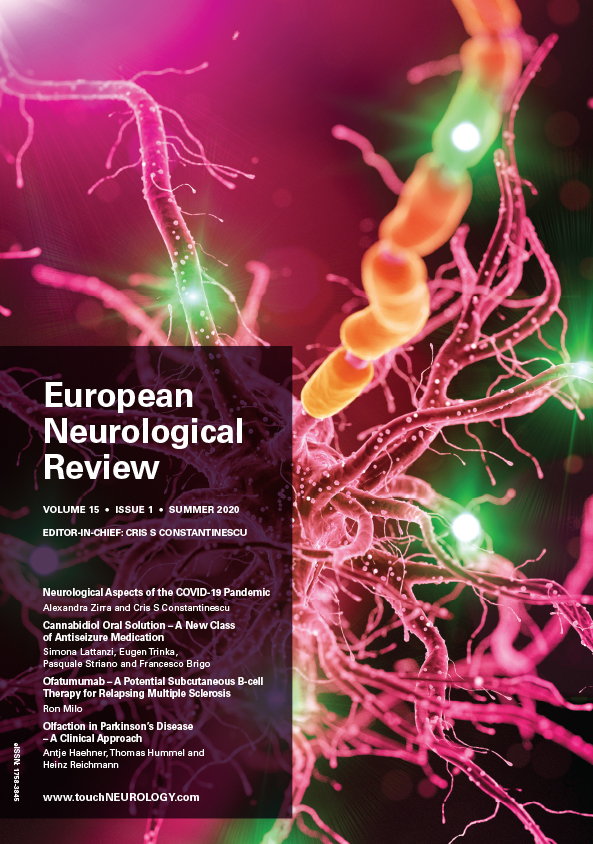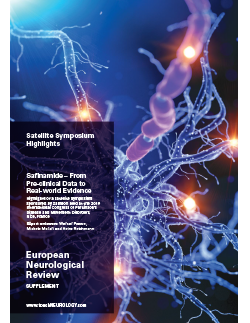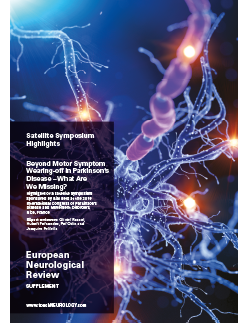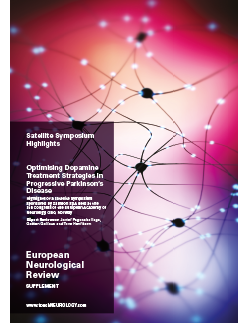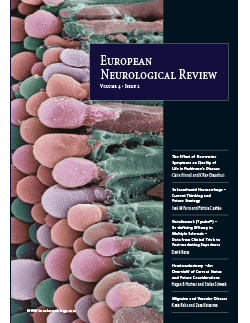
EUROPEAN NEUROLOGICAL REVIEW – VOLUME 4 ISSUE 2 – WINTER 2009
Foreword
Having been involved in the voluntary sector for the past 25 years, I have seen many changes in what is required ‘to prove the case’. Distress no longer has an impact and will not effect change, but evidence will. With a changing demography, migration and many cultural differences to understand, there are great challenges facing […]
Neurodegenerative Diseases
In the EU, more than seven million people are estimated to have dementia.1 An ageing population will lead to an increase in dementia cases,1 with prevalence rates in both western and eastern Europe expected to at least double by 2040.2 Worldwide, it is forecast that one in 85 people will be living with Alzheimer’s disease […]
Alzheimer’s disease (AD), described for the first time in 1906 by Alois Alzheimer, is a neurodegenerative disease and the most frequent cause of dementia worldwide. The major neuropathological hallmarks of the disease are loss of neurons and synapses, and senile plaques (extracellular aggregates primarily composed of β-amyloid; Aβ) and neurofibrillary tangles (aggregates of hyperphosphorylated forms […]
Alzheimer’s disease (AD) is the most common type of dementia and is characterised by memory loss and cognitive impairment in the elderly. These symptoms are attributed to the accumulation of abnormal structures, namely amyloid-β (Aβ) plaques and neurofibrillary tangles (NFTs). The latter structures first appear in the entorhinal cortex and parallel the clinical progression of […]
Parkinson’s disease (PD) is a progressive neurodegenerative condition1 affecting over 1 million people in Europe2 and North America.3 A systematic review of 25 incidence studies found that in eight studies, the mean age of symptom onset was 60–65 years, and >65 years in five studies.4 Unmet needs in PD therapy include improved efficacy, tolerability and […]
Parkinson’s disease (PD) affects about 1–2% of the population over 65 years of age and up to 3–5% of people 85 years of age and older.1 As the average age of the population increases, the prevalence of PD can be expected to rise. There is increasing awareness that the non-motor symptoms (NMS) of PD significantly […]
Performing two tasks simultaneously (dual task performance) is a frequent activity in human life. However, performing dual tasks can be difficult. When people attempt to perform dual tasks, performance is generally impaired, manifested by increased errors or reaction times compared with when the tasks are performed individually. Such a deterioration of performance is defined as […]
Brain Trauma
Current Thinking Epidemiology Subarachnoid haemorrhage (SAH) is a severe disease: although SAH accounts for only 5% of all strokes, it is responsible for 25% of all fatalities related to stroke. The incidence of SAH has not decreased in recent years, remaining stable at around 10/100,000/year.1 SAH is more common in females than in males (3:2). […]
Evidence-based stroke therapy using the thrombolytic agent recombinant-tissue plasminogen activator (rt-PA) aims at rapid recanalisation of the occluded vessel within the acute phase of cerebral ischaemia, thereby lacking direct neuroprotective or neuroregenerative properties to restrict subsequent ischaemic damage.1 In the search for promising neuroregenerative tools, stem cell treatment has come into the spotlight during the […]
Modulation of Baroreceptor Reflex Sensitivity May Represent a New Therapeutic Target in Acute Stroke
The baroreflex is one of the most important neural mechanisms involved in blood pressure regulation. Baroreceptors in the carotids, cardiac chambers and the aortic arch are activated by changes in blood pressure. The information from baroreceptors relays in the nucleus tractus solitarius and the ventrolateral medulla and is further processed in regions including the insula, […]
Stroke is the leading cause of long-term disability and the second leading cause of death worldwide. According to World Health Organization (WHO) estimates, 15 million people each year suffer from strokes and five million are left permanently disabled.1 Ischaemic stroke is the most common type of stroke, accounting for 65–80% of all strokes. Accumulated data […]
Longitudinal data comprising repeated measurements of the same individuals on a number of occasions arise frequently in a wide range of fields: medicine, public health, psychology, biology and more. The main objectives of a longitudinal study are to characterise changes in the response of interest over time and to examine the selected co-variates that contribute […]
Multiple Sclerosis
Multiple sclerosis (MS) is a chronic, inflammatory, and neurodegenerative disease in which T cells cross the blood–brain barrier and attack the myelin sheath, initiating an inflammatory cascade. The consequences of these events are plaques of demyelination, gliosis, and axonal degeneration.1 MS is the leading cause of non-traumatic disability among young adults, with a total estimated […]
Interferon beta (IFN-β) is now established as an effective maintenance therapy for multiple sclerosis (MS) that can both slow disease progression and reduce clinical exacerbations.1–6 Studies have demonstrated that the three widely used IFN-βa formulations – IFN-β1b 250μg (8MIU) by subcutaneous (SC) injection every other day (EOD; Betaferon®, Bayer Schering Pharma); IFN-β1a 44μg (12MIU) by […]
Cervical Dystonia
Dystonia is a neurological syndrome characterised by involuntary, sustained, patterned and repetitive contractions of opposing muscles, leading to twisting and repetitive movements or abnormal postures of the body part involved.1–4 Dystonic movements must be distinguished from other hyperkinetic involuntary movements such as chorea, myoclonus, tremor or tics. Dystonias can be classified according several factors: age […]
Dystonia is a symptom that involves involuntary muscle contractions that are frequently sustained, but can be phasic. These contractions or spasms frequently result in abnormal posturing or repetitive movements in various parts of the body. Dystonia is often accompanied by tremor.
Restless Legs Syndrome
Restless legs syndrome (RLS) is a common but frequently unrecognised condition characterised by uncomfortable and unpleasant sensations in the legs and an urge to move.1 The symptoms begin or worsen during periods of rest or inactivity, and they are relieved by activity.2 This relief generally persists for as long as the activity continues.
Epilepsy
It is estimated that epilepsy affects approximately 50 million people worldwide.1 Although conventional antiepileptic medications as well as newly developed ones have improved response in the majority of patients, it is known that up to 30% do not respond to appropriate therapy no matter how many antiepileptic drugs are administered.2 These non-responsive patients are candidates […]
Headache
Migraine is a common primary headache disorder with a lifetime prevalence of up to 33% in women and 13.3% in men.1 Almost one-third of migraineurs experience transient neurological (visual, aphasic, sensory and motor) symptoms known as aura before onset of headache. Although migraine is known to be a benign disorder, migraine and stroke have been […]
The second edition of the headache classification from the International Headache Society (IHS) has defined a new primary headache grouping named the trigemino-autonomic cephalgias (TAC).1 All of these headache syndromes have two features in common: relatively short-lasting, unilateral, severe headache attacks, and, typically, accompanying cranial autonomic symptoms. These autonomic symptoms occur on the side of […]
Imaging
Since the original conception and introduction of magnetic resonance imaging (MRI) gadolinium-based contrast agents (GBCAs) in the 1980s, many such contrast agents have been approved for use in contrast-enhanced MRI. These contrast agents have been used extensively in a large range of indications, particularly central nervous system examinations, as well as neurodegenerative diseases and tumoural […]
Functional magnetic resonance imaging (fMRI) is a fairly new tool that has been used to measure brain activation utilising the dependency of the magnetic properties of haemoglobin on the amount of oxygen it carries. Blood-oxygen-level-dependent (BOLD) signals measure the alterations in cerebral blood flow that mark functional brain activity.1 The intrinsic BOLD contrast makes fMRI […]
Clinical Features of Progressive Supranuclear Palsy
Surgery
In 2006, results from randomised controlled trials were published regarding decompressive surgery for the treatment of space-occupying ‘malignant’ middle cerebral artery (MCA) infarctions. Each of these studies and the pooled analysis provided evidence for a benefit of early hemicraniectomy with respect to mortality after three months. This article focuses on hemicraniectomy as the current treatment […]
Surgical-site infections remain a significant contributor to hospitalacquired infections despite continued efforts to reduce their occurrence. Infection at the operative site is associated with high morbidity, mortality, and prolonged hospitalization. Typically, in neurosurgical cases the infection rate varies between 1 and 4%. While antibiotic use,1 enhanced patient homeostasis (e.g. with respect to serum glucose levels […]
International Health
Brain disorders represent 35% of the total disease burden in Europe and 37% of the total disease burden in European regions with very low child mortality and low adult mortality; the latter group includes Italy.1 The negative socioeconomic impact of this burden is reflected in two fundamental issues: consumption of resources and state of health.2
Alzheimer’s disease (AD) is a neurodegenerative disorder of unknown aetiology, with the exception of a small percentage of cases related to mutations of the amyloid precursor protein (APP), presenilins and other, as yet unknown, genes.1,2 For sporadic cases of AD, many environmental and genetic risk factor modifiers have been described, but – with a few […]

Trending Topic
Welcome to this issue of touchREVIEWS in Neurology, where we explore significant advances in neurology, cognitive health, and wearable technology in the management of various chronic conditions. This issue brings together a collection of expert perspectives and research that spans innovative therapies, preventive strategies, and case studies, each offering critical insights for clinicians and researchers. […]
Journal Archive
European Neurological Review is a peer-reviewed, free-to-access, bi-annual neurology journal comprising review articles, case reports, practice guides, theoretical discussions, and original research. It features balanced and comprehensive articles written by leading authorities, addressing the most important and salient developments in the field of neurology in practical terms.
Latest articles videos and clinical updates - straight to your inbox
Log into your Touch Account
Earn and track your CME credits on the go, save articles for later, and follow the latest congress coverage.
Register now for FREE Access
Register for free to hear about the latest expert-led education, peer-reviewed articles, conference highlights, and innovative CME activities.
Sign up with an Email
Or use a Social Account.
This Functionality is for
Members Only
Explore the latest in medical education and stay current in your field. Create a free account to track your learning.


